Want to learn more about using electric fence for goats? Keep reading to learn how to set up your fence plus the pros and cons of using electric fencing for your goats!
Your fencing is so important when it comes to keeping your goats where you want them to be. And one of the options available is to use an electric fence for goats.
This site contains affiliate links. If you make a purchase using one of these links, I may earn a commission. Please see my disclosure page for more information about cookies collected and our privacy policy.
When we first moved to our current homestead we didn’t have any existing fencing. The land was overgrown and the terrain mountainous. And while we did make some pastures using the standard woven goat wire fence, electric fence was the best option for many of our goat pastures.
Don’t worry- electric fences are totally safe for your goats. If they get zapped by the hot wires, it will sting but it isn’t dangerous for them, even very young goats. And usually all it takes is once and they won’t touch it again!
How to Set Up an Electric Fence for Goats
Electric fencing can be a great option for full pastures. We use it in our most uneven terrain pasture and haven’t had any problems with escaping goats.
To set up your electric fence you will need:
- T-posts
- Galvanized steel wire or aluminum wire
- T-post Insulators
- Corner post insulators
- Electric fence charger* (Always better to get one stronger than you think you need!)
- Grounding rods (2-3 is optimum)
To place your fence, dig in your t-posts about 12-16 ft apart. This is another plus of using electric fencing for goats as opposed to woven wire- you don’t need as many posts!
You will want to have 4-5 strands of electric wire for your goat fence, which means each t-post will need 4-5 insulators on them. We like to place these insulators as we pound the posts in since it saves a little time.
Once you have your posts up along the perimeter of your fence line, it’s time to string the wire.
We start our electric fences with corner post insulators. Simply attach the insulator to your starting point and wrap the wire around. Do this for each strand of wire.
Related Reading: 6 Fencing Mistakes That Are Costing You Time and Money
We place our hot wires about every 9 inches. So 9 inches above the ground, then at 18 inches, 27 inches, and 36 inches for a 4-strand fence.
Pull the wire tight when stringing it so that it doesn’t sag. In corners you will need to use the corner insulators again.
When you get to your stopping point, secure the wire to the end insulator, being sure to pull the wire tight.
We are able to get an 4-5 strand electric fence for a 1+ acre pasture up in just a few hours- much quicker than pulling woven wire! And much less expensive!
When it comes to installing your electric fence charger it is best to follow the directions on the one you have purchased.
In general, you will need to attach the charger to the fence and then also to your grounding rods. Follow the instructions to set this up correctly.
Pros of Using Electric Fence for Goats
It is cheaper. Woven wire is EXPENSIVE. So if you have a large pasture- electric fencing is much more cost effective.
Easier to construct on uneven or hilly terrain. We have tons of hills and dips and whatever our mountains might decide to give us! Woven wire can be a nightmare to do without leaving gaps where a goat might get under (and get stuck). Electric wire won’t have this issue.
It is quicker to install. Woven wire can take a lot of pulling to get tight enough and it takes time to wire each post 3-4 times with t-post clips. Electric is much quicker and easier to pull tight and it takes no time to get the wire in the insulators.
Your goats can’t climb or push on the fence. And most goats will respect the hot wires. They can sense the current and usually won’t go near it. They don’t want to get hit with 7,000 volts!
Related Reading: The Ultimate Guide to Fencing on the Farm
Cons of Using Electric Fences for Goats
The main con of an electric fence for goats is that it is only a psychological barrier, meaning if the goat is stubborn or really wants to cross that barrier they can.
I have never had a problem in this area, but it can be an issue especially during breeding season. We do not use electric fencing for our bucks in the fall since they will do anything to get to the does- even get shocked.
The fence could fail. You could have a power failure, battery failure, charger failure. Things like limbs, weeds, and even bugs can short out your fences every now and again.
Our goats seem to be used to the electric fence being there so that even when the fence does go down, as long as we get it back working ASAP they don’t test it. Though I am sure if it were down for a week they would realize and start exploring!
It’s more work to keep the fence line clean. In the summer, it can be a hassle to keep the fence line trimmed. Your goats can’t eat along it like they do with wire fences, and if you let the weeds and grass get to high the fence will ground out. (note: if you get a strong enough charger, this may not be an issue)
If you are looking for other fencing options- be sure to check out my post on the different fencing options for goats.
Other Ways to Use Electric Fence for Goats
In addition to fencing full pastures, you can use electric fences in other ways with your goats.
Electric fencing is a great way to divide pastures for rotational grazing. They are simple to construct to divide larger pastures into smaller ones.
You can also use a single strand of electric along the top of a physical woven wire fence. This is great for bucks and for goats that are stubborn and like to climb or jump your fences.
Electric netting can also be used to create quick, temporary areas for your goats to graze. If you have a problem area on your property you can use this electric netting to fence your goats in for a few hours or the day while they eat down the weeds and brush in that area.
We love our electric fence for our goat herd and have used it successfully for the past 6 years. If you need a good, inexpensive, and quick to put up fence- give it a try!
*Choosing an Electric Fence Charger
When choosing an electric fence charger it’s always best to choose one that is stronger than you think you need.
Your fence charger needs to stay at a minimum of 5000 volts at all times to keep your goats contained and keep predators out.
The voltage level of your fence can be impacted by a lot of things such as the length of your fence, the kind of wire you are using, and any vegetation that may be on the wires.
Remember when choosing a fence charger, the listed fence length is based on one single strand, and for goats you will have 4-5 strands of wire. Keep this in mind and make sure that if you divide the chargers listed fence length by 5, it will work for your goat pasture size.
It’s also important to read the description of the electric fence charger to make sure it’s rated for larger animals and predators, NOT pets and small nuisance animals.
Electric Fence Chargers for Goat Fences
We have successfully used electric fence with our goats for over 8 years. The only time we have problems with goats getting out is when we let the fence ground out, so it’s a great inexpensive option to fence in your goat pen quickly and efficiently.
Read more about raising goats with my quick start guide!
Electric Fence for Goats FAQ
Do electric fences work on goats?
Yes! Electric fences are very effective for containing goats. One thing to remember is that electric fences are psychological barriers. Goats can get through them if they really want to. This means they aren’t always the best option for bucks- especially during breeding season.
How many strands of electric fence do I need for goats?
4-strands of electric wire is best when building a fence for goats. The strands should be spaced about every 9 inches. So 9 inches above the ground, then at 18 inches, 27 inches, and 36 inches for a 4-strand fence.
How strong should an electric fence be for goats?
Your fence charger needs to stay at a minimum of 5000 volts at all times to keep your goats contained and keep predators out.

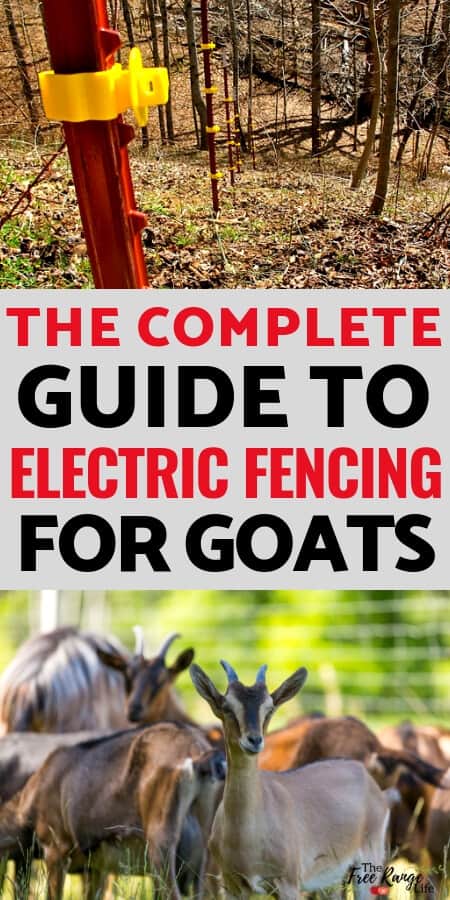
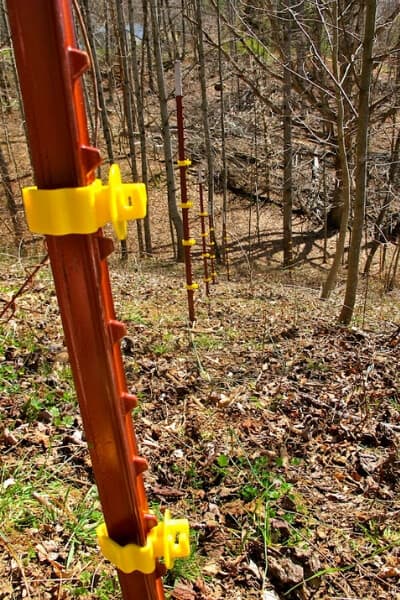
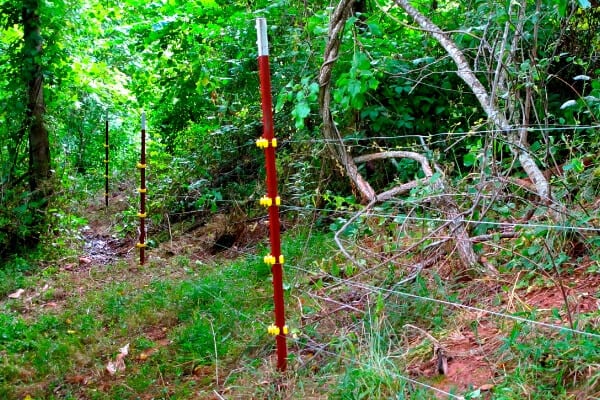
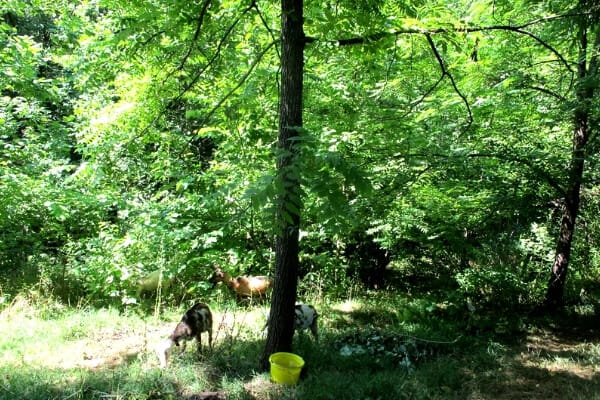
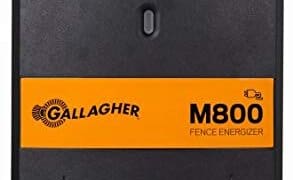
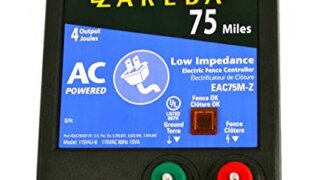
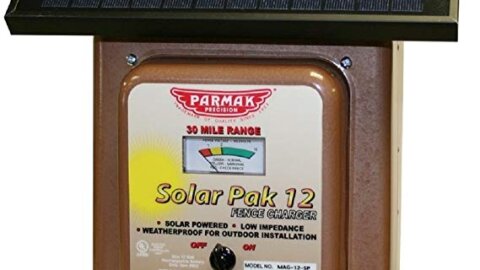
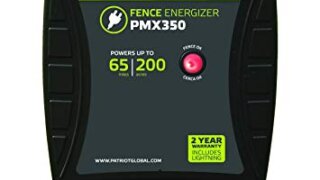
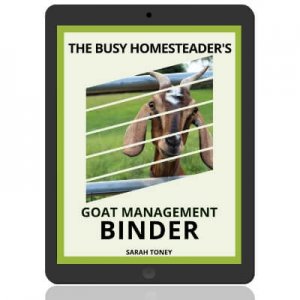

I use a single strand of the yellow wire for horses around the inside of my pens.Keeps everyone in their respective fields. Even my buck.
We have a wether who thinks he’s Harry Houdini. He has even pushed a hole in some woven fencing we used; he actually broke the wires. I’m going to try some electric wiring for him. He also thinks he belongs in the house with us and will stand at the door and head butt it to get us to open the door for him.
What electric fencer do you use? Should it be a pulsing or a constant?
You want a pulse with a shorter interval if possible. Longer intervals save power and Solar chargers seem to have longer intervals for this reason. Some chargers have a variable pulse width and can vary that pulse width to save power say at night. Ive used it on the shorter setting to get the animals used to yhr fence then cut it back to the longer setting after they got used to it but the shorter pulse intervals are always better if you can manage them
How strong of electric fencer is good. We have cows also so can we use the same charger?
A well designed e fence will contain sheep goats and cattle. You do not need a more powerful energiser for cattle. The trick is to get wires spaced correctly. Goats try to go under and over. Sheep go through. Cattle push so put a wire or two for them at mid height. Use earth wires as well as live wires if the soil is poorly conductive – dry.
Will this keep coyotes out? Have you had issues with coyotes attacking goats? We don’t have goats yet but have heard the coyotes in the back woods. We also have chickens – can they free range with goats and will the lowest wire keep them deterred from getting out? Finally – we have dogs – that’s the number one reason we’re looking into electric fencing. We want to keep our labs in…if we get goats later will that work with dogs?
It will keep coyotes out but get a powerful charger. My experience with birds is that the electric doesnt deter them at all, they are too well insulated and you need a physical barrier. It will keep predators out fir tge most partbut you need the wires pretty clise together at thr botto for things like weasels, raccons etc and a mesh works better fir that Ive found. Of course those lower wires mean you have to keep the weeds mowed down. You could install a tight mesh wire fence near the ground, say 2-3 feet then run electric above that and that would also work. If you have Coyote or other digging predator problems and use a wire fence, run a really gnarly ,barbed wire strand with as many barbs per inch as possible as close to the ground as possible to deter them from digging under the fence
My understanding is that barbed wire becomes quite dangerous if you let it become electrified (an animal or human that gets pierced by the barb has one skin entry point bypassed; this effectively doubles the current. If, God forbid, something managed to get pierced by two barbs (one earthed) you’d get thousands of times the current running between the two barbs (I’ve heard anecdotes of people killing themselves with 9v batteries by bypassing their skin, and the biophysics does check out)
Thank you for this article! Found it very helpful. Can you suggest wire fence to use? Company? And do you know how much of it would be needed to cover 2-3 acres?
I used an electric fence for sheep from the mid 70s to the late 80s. The disadvantage was clearing and keeping clear the fence line in wooded areas. Now I have goats. I first put up a welded wire fence. Goats step on it and rub against it and break it. The next I tried was livestock or field fence. The goats can bend it down. The latest is goat fence. It only comes in 330 foot rolls and is very heavy so you need a team of men to install it.
I think that an electric fence will work where you can keep the grass mowed and don’t plan to leave the fence very long.
Usually when you purchase an electric fence, the energizer box will state what type of animals it should be used on. The great thing I love about an electric fence is that it trains livestock to stay away. This has even worked for our cattle. Like mentioned in the above comment, if you want to keep something out and do not really have an issue of livestock trying to leave, definitely get a higher power energizer to keep coyotes out. Coyotes are a major problem here in southern Texas and electric fences are a common thing that helps us keep them away.
How do you do your corners with tpost? Do you brace them in any way?
T Posts are not suitable for corner posts. 2 wooden posts with cross bracing (wire) can be effective, if used in both directions from the corner posts.
Question: most of the time I may need a temp elect fence only 80’ long – these rolls are so much longer! How do I set up/handle the excess fence? Thank you!
Do you stretch the wire by hand or use one of the pulley things
always use a come along, or something mechanical to stretch and pull those woven wire fences. you need a chain and or a strong rope to pull these things right. my neighbor use his winch on his gator. make sure the bottom is secured right first and work you way up. secure all post on the ground, and use cross bracing as well. a straight line is always best, and make sure the wire is on the side that the goats are inside of. they will push, climb, jump ect. I always put a hot wire about 1 foot inside fence perimeter and one on top as well.
thank you for the article
How many joules do you recommend for fencing goats. I am using polywire and running for strands 300 feet long?
What is the longest post spacing for does, baby goats with mother, baby goats alone and bocks you would consider? Blessings….